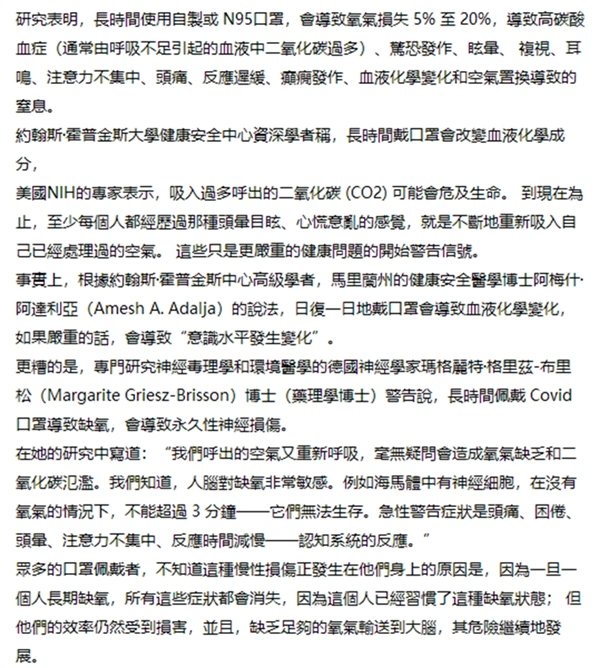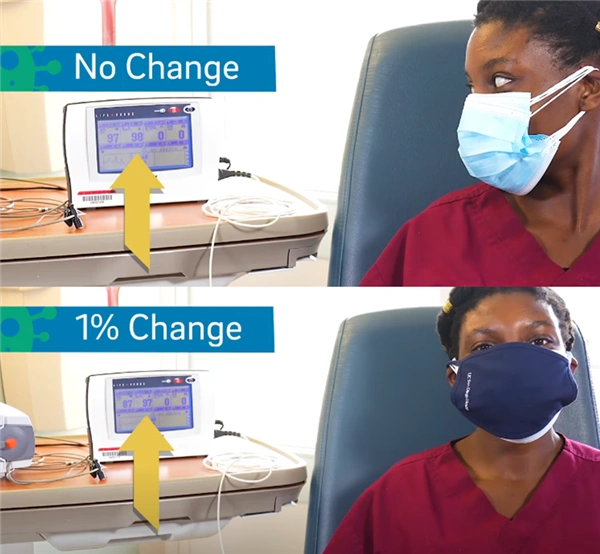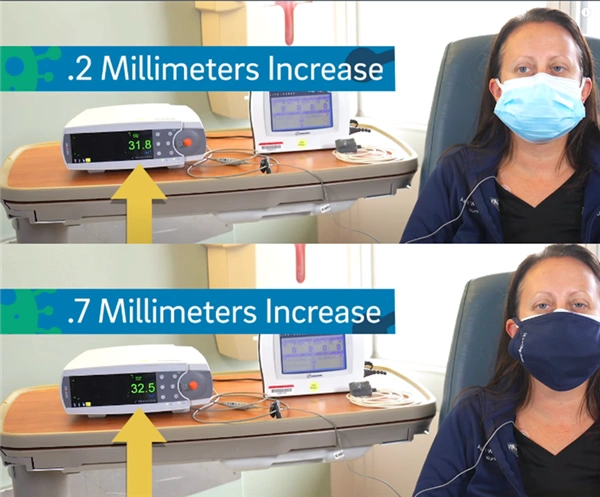There have been quite a few rumors about masks, some of which are extremely absurd. For instance, someone shared in a wechat group that wearing masks might lead to oxygen deficiency and cause various health problems for people.

At first glance, this rumor seems well-grounded and serious, but to evaluate it, only four words are needed:
A pack of lies.
01 Do masks really affect breathing?
After putting on a mask, it does make people feel a bit uncomfortable and even a little uncomfortable. But does this really mean that normal breathing will be affected, to the extent that, as rumored, blood oxygen levels drop and hypercapnia occurs? Let's look at a small experiment first. The Office of Health at the University of California, San Diego, once shot an experimental video on whether masks could affect breathing, and the result was simply astonishing. The experimenter first measured her blood oxygen saturation, which was 98% - a lower value indicates hypoxia. Then she wore four layers of masks at a time and measured her blood oxygen saturation again, only to find that it was still 98%. After adding three layers of masks, her blood oxygen saturation only dropped to 97%.

From the experimental video, note that the blood oxygen number is 98 in the upper picture and 97 in the lower picture. So what does this mean? Will this degree of change affect our breathing? The conclusion is negative. In fact, a blood oxygen concentration between 95% and 100% is normal, and the body may not have any reaction to such a small change. There is no problem with oxygen. But what about carbon dioxide? In this experimental video, another subject first tested the partial pressure of carbon dioxide in their body, which was 31.6mmHg. After wearing four layers of masks, the value rose to 31.8mmHg. After adding three more layers of masks, it only increased by 0.7mmHg to 32.5mmHg.

For ordinary people, the normal range of carbon dioxide partial pressure is between 30mmHg and 45mmHg. It can be seen that the impact of masks is also negligible. As for some people insisting that masks make it difficult for carbon dioxide to be discharged, causing people to inhale them and get poisoned, this is also unreliable. On the one hand, it is dangerous for people to inhale carbon dioxide with a concentration as high as 10%, while the concentration of carbon dioxide in our daily air is only 0.04%. Even the exhaust gas we exhale has a carbon dioxide concentration of no more than 4-5%. Only operations like sticking your head into a plastic bag and tying it tightly may cause the problem of excessively high carbon dioxide concentration. Medical masks worn by ordinary people in daily life are breathable. Although they need to breathe with a little more force than usual, it is not difficult for them to inhale enough oxygen and exhale carbon dioxide properly.
02 Different people wearing different masks have different effects
After reading the previous text, we should already know that wearing ordinary medical masks will not affect our oxygen supply. As a result, all the rumors that masks cause oxygen deficiency and high carbon dioxide concentration, leading to diseases, will naturally be refuted. However, the previous text mentioned that healthy people should wear ordinary medical masks. There are still some special circumstances that need to be noted. Let's briefly talk about them below. For the masks we wear daily, the first choice is ordinary medical masks, such as N95 or masks with higher filtration performance, which are more suitable for professionals in high-risk environments. Ordinary people who wear N95 masks for a long time are prone to discomfort. In addition, for people who are already prone to breathing difficulties, such as smokers, emphysema patients, and obese individuals, wearing N95 masks will make the situation even worse and may even exacerbate their breathing problems. In addition, for patients with certain lung diseases such as pulmonary fibrosis, wearing masks may indeed affect blood oxygen levels. However, such patients are more likely to develop severe symptoms when infected with the novel coronavirus. Therefore, if one needs to move around in a closed public place, wearing a mask for a short period of time is more beneficial than detrimental. There is another question that has troubled many friends, that is, can masks be worn when exercising? Surprisingly, research has shown that at least for healthy young people (with the age of the participants being 28.2±8.7 years), there is no need to worry about oxygen deficiency even when exercising with a medical mask on, although it might be a bit uncomfortable. As for wearing it in daily life, there is even less of a problem. Of course, the listing of this study here is only to show that wearing a mask is not dangerous, and it is not to suggest that everyone exercise with a mask on.
03 There are still these misunderstandings about masks
Now that we understand that masks do not affect our normal breathing, let's review some other misunderstandings about masks. This can help you use masks better and prevent COVID-19. I don't feel any difficulty breathing even with a mask on, do I? Friends who have this feeling are very likely not wearing masks correctly... If you still feel smooth breathing while wearing a mask, you should check whether the shape of the metal nose clip on the bridge of the nose has been pressed to fit the bridge of the nose and whether there is any air leakage at the chin. If the mask is worn correctly, there should be a slight hindrance when breathing. If your glasses fog up when you breathe while wearing a mask in winter, it also indicates that the bridge of your nose is likely not adjusted properly.


 13-May--2025
13-May--2025